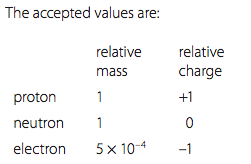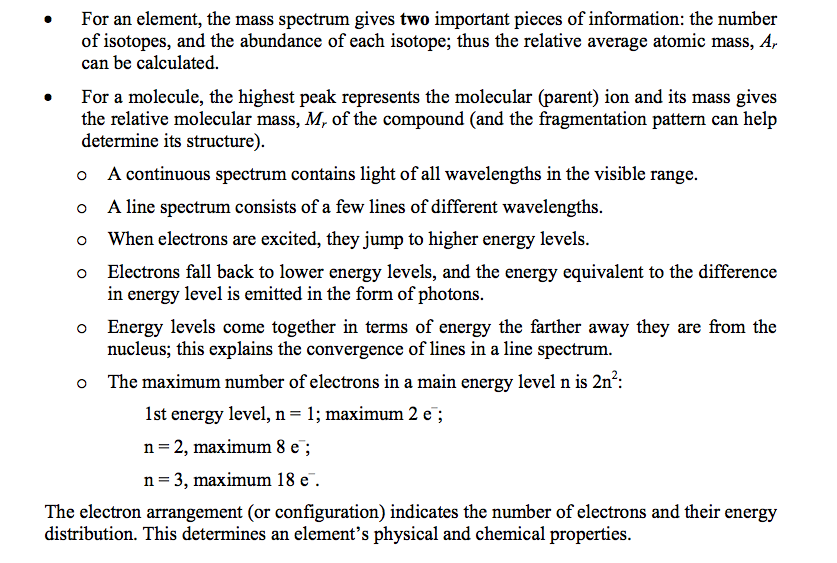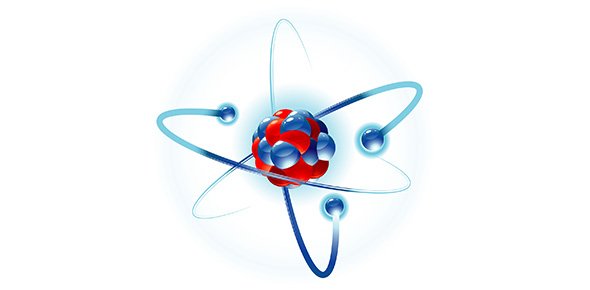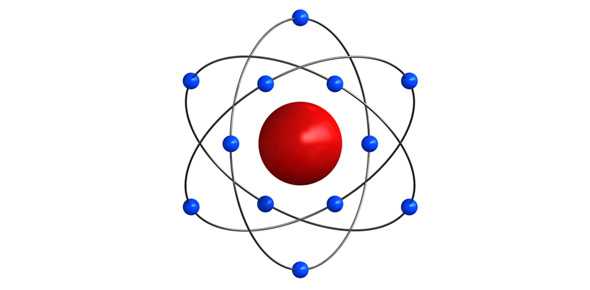Related Flashcards
Related Topics
Cards In This Set
| Front | Back |
|
2.1.1:
State the position of protons,
neutrons and electrons in the atom.
|
P+N in nucleus. Electrons orbiting in electron cloud surrounding nucleus.
|
|
2.1.2:
State the relative masses and relative
charges of protons, neutrons and
electrons.
|
 See image. |
|
2.1.3:
Define the terms mass number (A),
atomic number (Z) and isotopes of an
element.
|
Mass Number: AX : the A, represents the total number of protons and neutrons in the nucleus of an
atom.
Atomic number: ZX: The Z, represents the total number of protons in the nucleus of an atom.
Isotope: Atoms with the same number of protons but different numbers of neutrons.
|
|
2.1.4:
Deduce the symbol for an isotope
given its mass number and atomic
number.
|
The following notation should be used: AZ X , for
example, 12C
|
|
2.1.5:
Calculate the number of protons,
neutrons and electrons in atoms and
ions from the mass number, atomic
number and charge.
|
For Hydrogen:
Atomic Number: 1Mass Number: 2Charge: Neutral |
|
2.1.6:
Compare the properties of the
isotopes of an element.
|
Similar chemical properties.Slightly different physical properties e.g. m.p, b.p, and density.
|
|
2.1.7:
Discuss the uses of radioisotopes
|
Examples should include 14C in radiocarbon dating,
60Co in radiotherapy, and 131I and 125I as medical
tracers.
Students should be aware of the dangers to living things of radioisotopes but also justify their usefulness with the examples above. |
|
2.2.1:
Describe and explain the operation of
a mass spectrometer.
|
A simple diagram of a single beam mass
spectrometer is required. The following stages
of operation should be considered: vaporization, ionization, acceleration, deflection and detection. VIADD
|
|
2.2.2:
Describe how the mass spectrometer
may be used to determine relative
atomic mass using the 12C scale.
|

|
|
2.2.3:
Calculate non-integer relative atomic
masses and abundance of isotopes
from given data.
|
Straightforward.
Relative Atomic Mass = %*Mass + %*Mass |
|
2.3.1:
Describe the electromagnetic
spectrum.
|
Students should be able to identify the ultraviolet,
visible and infrared regions, and to describe the
variation in wavelength, frequency and energy
across the spectrum.
|
|
2.3.2:
Distinguish between a continuous
spectrum and a line spectrum.
|
Continuous spectrum: A spectrum representing all the colours of the rainbow: ROYGBV, with no
distinction between colors.
Line Spectrum: Also known as absorption spectrum, all wavelengths have been absorbed by an atom
(or whatever) as the light has passed through, except a few and these are shown as lines on the
spectrum.
|
|
2.3.3:
Explain how the lines in the emission
spectrum of hydrogen are related to
electron energy levels.
|
Students should be able to draw an energy level
diagram, show transitions between different
energy levels and recognize that the lines in a line
spectrum are directly related to these differences.
An understanding of convergence is expected.
Series should be considered in the ultraviolet,
visible and infrared regions of the spectrum.
Calculations, knowledge of quantum numbers and
historical references will not be assessed.
Emission spectrum: Shows the wavelengths of the lines that have been emitted, will consist of a continuous spectrum with a few lines blacked out. (that have been absorbed). Movement between energy levels requires energy, energy differences correspond to spectral lines |
|
2.3.4:
Deduce the electron arrangement for
atoms and ions up to Z = 20.
|
For example, 2.8.7 or 2,8,7 for Z = 17.
The maximum number of electrons in a main energy level n is 2n^2: 1st energy level, n = 1; maximum 2 e–; n = 2, maximum 8 e–; n = 3, maximum 18 e–. |





